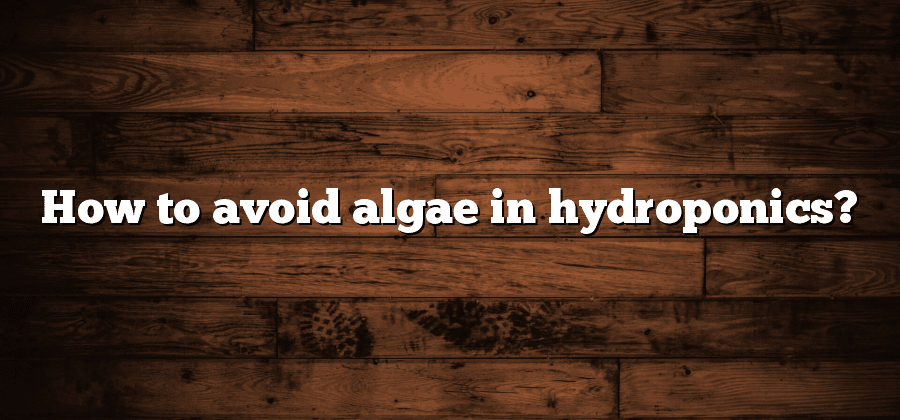Understanding Algae Growth in Hydroponics
Algae growth is a common issue that hydroponic growers often encounter. Algae are single-celled organisms that thrive in moist environments, making hydroponic systems an ideal breeding ground. They can be seen as green or brownish slimy patches on the surface of the growing medium or roots, causing blockages and disrupting nutrient absorption.
The main cause of algae growth in hydroponics is excessive exposure to light. Algae require light for photosynthesis, and when light penetrates the nutrient solution or growing medium, it promotes their rapid multiplication. It is essential to implement effective light control measures to mitigate algae growth. This can be achieved by using light-blocking materials such as opaque covers or by strategically positioning the hydroponic system in a location that limits exposure to natural or artificial light. Additionally, ensuring a consistent period of darkness for the plants can help reduce algae growth.
Maintaining Proper Nutrient Levels
When it comes to hydroponic gardening, maintaining proper nutrient levels is essential for the healthy growth and development of plants. In this method of cultivation, plants are grown in a nutrient-rich water solution instead of traditional soil. This means that they solely rely on the nutrients provided through the water for their nourishment.
To ensure that your plants receive the ideal levels of nutrients, it is crucial to regularly monitor and adjust the nutrient solution. This can be done by testing the pH level and conductivity of the solution using specialized meters. pH levels should be maintained within the optimal range for the specific plant species being grown, as fluctuations can hinder nutrient absorption. Similarly, maintaining appropriate levels of macronutrients such as nitrogen, phosphorus, and potassium, as well as micronutrients like iron, magnesium, and zinc, is vital for healthy plant growth. By carefully monitoring and adjusting the nutrient solution, you can provide your plants with the precise amounts of nutrients they need to thrive in a hydroponic system.
Implementing Effective Light Control
The importance of effective light control in hydroponics cannot be overstated. Light is one of the key factors that directly influences the growth and development of plants. It is essential to provide the right amount and type of light to ensure optimal photosynthesis and prevent detrimental effects such as light burn.
When implementing light control in a hydroponic system, it is crucial to understand the specific light requirements of the plants being grown. Different plants have different preferences for light intensity, duration, and even color spectrum. Therefore, it is important to provide plants with the appropriate light conditions that mimic their natural growing environment. This can be achieved by using adjustable lighting systems that allow for precise control over the intensity and duration of light exposure. Additionally, utilizing different types of light sources such as LED grow lights can help provide the right spectrum of light for various growth stages of plants. With effective light control, hydroponic growers can optimize plant growth and achieve higher yields.
Choosing the Right Hydroponic System
When it comes to choosing the right hydroponic system, there are several factors to consider. It is important to assess your specific needs and goals for your hydroponic setup. One factor to consider is the size of the system and the space you have available for it. If you have limited space, a compact system such as a vertical or vertical garden might be a suitable choice. On the other hand, if space is not an issue, larger systems such as nutrient film technique (NFT) or deep-water culture (DWC) might be worth considering for their higher yield potential.
Another factor to consider is the level of experience and expertise you have in hydroponics. If you are new to hydroponics, it might be beneficial to start with a simpler system such as a wick system or a simple drip system. These systems require less monitoring and maintenance compared to more complex systems.
Additionally, consider the type of plants you intend to grow. Some plants thrive best in specific hydroponic systems. For example, leafy greens and herbs tend to do well in nutrient film technique (NFT) systems, while larger fruiting plants like tomatoes may require a deep-water culture (DWC) or a Dutch bucket system.
In conclusion, choosing the right hydroponic system involves careful consideration of factors such as space availability, level of experience, and plant requirements. By thoughtfully analyzing these factors, you can select a hydroponic system that aligns with your goals and maximizes your chances of success in hydroponic gardening.
Using Sterile Growing Mediums
For hydroponic systems to thrive and produce optimal yields, it is crucial to use sterile growing mediums. Sterile growing mediums play a vital role in preventing the growth of unwanted pathogens, pests, and diseases that can hinder plant growth and productivity. By using sterile growing mediums, growers can ensure a clean and controlled environment for their plants to thrive.
One of the main advantages of using sterile growing mediums is that they reduce the risk of contamination and disease transmission among plants. Traditional soil-based gardening often faces challenges related to soil-borne diseases and pests that can severely damage or even kill the plants. However, by using sterile growing mediums such as rockwool, coco coir, or perlite, growers can eliminate these risks and ensure a healthy growing environment. Sterile growing mediums also provide excellent water retention and oxygenation properties, facilitating optimal root development and nutrient absorption. Additionally, these mediums are usually pH neutral, allowing growers to maintain proper nutrient balance and prevent nutrient deficiencies or toxicities.






